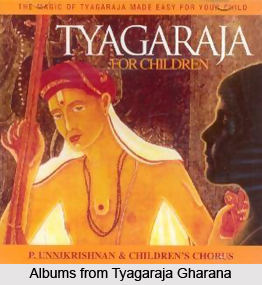 Musical compositions of Tyagaraja are known as Kritis. There are three `angas` (sections) of a Kriti known as Pallavi, Anupallavi and Charanam. Based on the nature of the text (Sahitya) Kritis are classified as Ekadatu, Dvidhatu and Tridhatu. If there are many charanas, each charana has the same dhatu. There are differences in musical renderings of these kritis. The textual consistency is fairly good. Printed versions of the kritis were first made available by A.M. Chinnasami Mudaliar (AD 1893), who printed and circulated them in instalments through the magazine Oriental Music in European Notation, many more editions of the compositions followed in due course. Statistical information is provided by K.R. Rajagopalan of Madras Christian College, Tambaram. Before Chinnasami Mudaliar`s pioneering attempt, the kritis were being circulated by Harikatha performers (performers of musical discourses). Mostly they were `memory narratives`, transmitted from preceptor to pupil. The lacuna caused by this mode of transmission lies in the fact that people are unable to arrange the Kritis chronologically on the basis of their genesis.
Musical compositions of Tyagaraja are known as Kritis. There are three `angas` (sections) of a Kriti known as Pallavi, Anupallavi and Charanam. Based on the nature of the text (Sahitya) Kritis are classified as Ekadatu, Dvidhatu and Tridhatu. If there are many charanas, each charana has the same dhatu. There are differences in musical renderings of these kritis. The textual consistency is fairly good. Printed versions of the kritis were first made available by A.M. Chinnasami Mudaliar (AD 1893), who printed and circulated them in instalments through the magazine Oriental Music in European Notation, many more editions of the compositions followed in due course. Statistical information is provided by K.R. Rajagopalan of Madras Christian College, Tambaram. Before Chinnasami Mudaliar`s pioneering attempt, the kritis were being circulated by Harikatha performers (performers of musical discourses). Mostly they were `memory narratives`, transmitted from preceptor to pupil. The lacuna caused by this mode of transmission lies in the fact that people are unable to arrange the Kritis chronologically on the basis of their genesis.
Of the studies on Tyagaraja`s lyrics published so far, William. J. Jackson`s Tyagaraja: Life and Lyrics is an attempt to contextualize Tyagaraja in a socio-historical framework. In his own words, `A study of historical events which partially shaped the times ... can deepen our understanding of the artist`s life and works even if the artist himself has not carefully cherished ... bitter memories of specific historical realities undergone, such as disruption, famine and war.`
This article is a stub. You can enrich by adding more information to it. Send your Write Up to content@indianetzone.com




















